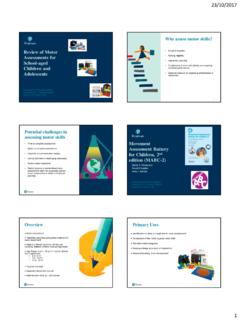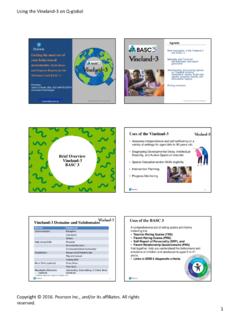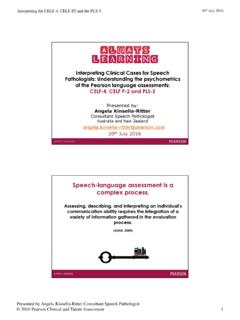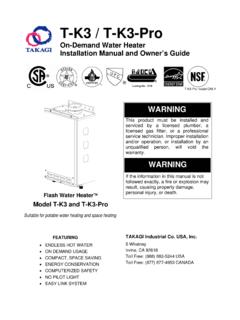Transcription of PowerPoint Presentation
1 15/09/2017 1 Getting the Most out of the Adult and Adolescent Sensory Profile Amy Schulenburg Consultant Occupational Therapist Pearson Clinical Assessment (A/NZ) Agenda of Dunn s Sensory Processing Model & Framework of the Adult & Adolescent Sensory Profile the Sensory Profile to guide Intervention Studies Part 1: Review of Dunn s Sensory Processing Framework Dunn s model of sensory processing Neurological threshold: the amount of stimuli required for a neuron or neuron system to respond Behavioural response: the way a person acts in consideration of his/her neurological threshold Thresholds for response Dunn s Model of Sensory Processing 6 Neurological Threshold Continuum Behavioural Response Continuum PASSIVE ACTIVE HIGH threshold (habituation) LOW threshold (sensitisation)
2 Low Registration Miss sensory information Easygoing Sensory Sensitivity Continually detecting sensory input Heightened awareness Sensation Seeking Continually adding sensory input to tasks Likes to be busy Sensation Avoiding Withdraws from overwhelming sensory input Likes order and routine 15/09/2017 2 Dunn s sensory processing framework Dunn s sensory processing framework Seeking the degree to which a person obtains sensory input Avoiding the degree to which a person is bothered by sensory input Sensitivity the degree to which a person detects sensory input Registration the degree to which a person misses sensory input Everyone has a Sensory Profile! Sensory processing is a concept that explains how we experience life through our senses The Sensory Profile helps to identify sensory preferences rather than a sensory disability or disorder More than others or Less than others scores alone do not indicate the presence of a functional problem Conclusion Sensory processing is a fundamental part of being human Every person has a Sensory Profile There is no right or wrong Sensory Profile Dunn s sensory processing framework describes a person s sensory preferences and patterns of behaviour Thinking about sensory processing helps us to gain a more holistic view of people we work with Part 2.
3 Adult and Adolescent Sensory Profile Overview of the test Measures sensory processing abilities by self report Profiles effects of sensory processing ability on functional performance in everyday life Gives information about a person s tendencies to respond to stimuli & which sensory systems are contributing to or creating barriers to functional performance Provides standardised quadrant scoring (Much less than most people Much more than most people) 12 15/09/2017 3 Who is it for? 13 Individuals aged 11-65+ People with physical disabilities People with psychiatric conditions People with no identified disability When should I use it? To establish a baseline of sensory processing in everyday situations To guide intervention and clinical decision making To raise awareness of sensory processing as a contributor to behaviour, for both clients and staff To assess whether sensory processing patterns are compatible with daily living situation 14 Administration Frequently asked Question Q: If my client is unable to complete the questionnaire ( due to low IQ, impaired communication, inability to attend, etc.)
4 , can a caregiver complete the form? A: Yes, but you should not report the standardised categories ( more than others). Because the normed data for those categories was derived from self-report questionnaires. You can still get lots of useful information about the client s preferences. Q: What qualifications do I need to have to administer the Sensory Profile? A: Anyone can administer it, but it takes additional skill to relate the findings to everyday participation challenges, this usually requires the expertise of an OT. Sample of Questions Scoring Almost always = 5 points Frequently = 4 points Half the time = 3 points Occasionally = 2 points Almost Never = 1 point Reliability and Validity Internal consistency for quadrants range from .65 - .78 Each item on a subscale correlates best with its intended subscale Standard error of measurement ranges from Discriminant Validity with Adult Temperament Questionnaire (Chess & Thomas, 1998)
5 Sensation seeking scores negatively correlated with withdrawal and dysphoric mood subscales Sensitivity subscales positively correlated with dysphoric mood and sensory threshold subscales Sensation avoiding positively correlated with low adaptability, withdrawal and dysphoric mood 15/09/2017 4 More support for validity Physiological data consistent with four quadrants using skin conductance measures of responsivity Sensory sensitivity respond intensely and habituate slowly Sensation avoiding respond intensely but habituate quickly Low registration respond weakly and habituate quickly Sensation seeking respond weakly but habituate slowly Additional validity studies Distinguished people with and without mental illness Distinguished younger and older adults Findings related to specific populations Individuals w ith Schizophrenia Low scores on sensation seeking High scores on sensation avoiding and low registration Individuals w ith Bi-polar Disorder Average scores on low registration High scores on sensation avoiding and low scores on
6 Sensation seeking Older Adults Low scores on sensation seeking High scores on low registration with cumulatively higher scores as age from 60 70 - 80 Individuals w ith Autism/Aspergers More likely to exhibit behaviors in sensation seeking, low registration and sensory sensitivity Especially sensitive to auditory and oral motor input Individuals w ith ADHD Differences across all quadrants may be more reflective of a modulation problem Adults with Brain Injury High scores on sensory sensitivity Low scores on sensation avoiding Part 3: Interpretation and Using the Sensory Profile to guide Intervention Interpretation of Questionnaire Start broad by using quadrant summary chart to compare against norm group for each age range Get more detailed by using Appendix B for further analysis within each sensory area (pattern grids)
7 Then get more detailed by going to individual questions to look for trends in terms of both thresholds and behavioural response Scores do not in themselves identify a difficulty or impairment All sensory processing preferences have advantages and disadvantages Low scores are as meaningful as high scores Consider other factors cognitive, behavioural 22 Interpretation of Quadrants Quadrant scores are independent of one another not part of one continuum Each quadrant has its own continuum Every person has some aspects of each quadrant in his/her individual sensory processing patter Sensory processing patterns may impact participation differently across different environments It s possible to be different extremes depending on what sensory system is involved ( seeking vestibular but sensitivity to auditory) It s possible to be two extremes in the same sensory system depending on locus of control ( might hate being touched by others but love messy activities)
8 24 15/09/2017 5 Pattern Grids Appendix B Reproducible pattern grids Allow analysis of performance within different sensory modalities Compare thresholds and behavioural responses 25 Making it all about occupational performance Law, M., Cooper, B,. Strong, S., Stewart, D., Rigby, P. & Letts, L. 1996. The Person-Environment-Occupation Model: A transactive approach to occupational performance. Canadian Journal of Occupational Therapy. 63(1):9-23. Occupational performance is the product of the dynamic relationship among persons, their occupations and roles and the environments in which they live (Law et al, 1996) Person Occupation Environment Person-Environment-Occupation Model Occupational performance Making it all about occupational performance The Sensory Profile tells us about the person Occupational performance will vary depending on the level of congruence between the P, E and O Starting with a sensory hypothesis makes interpretation and reporting much easier In formulating our hypothesis, testing the hypothesis and implementing intervention, we need to also think about the sensory aspects of the environment and occupation Intervention Planning When using quadrant scores to guide intervention, the goal is to offer sensory input that supports sensory processing patterns.
9 To facilitate participation Intervention should ideally be designed as part of daily routines Administration manual has a chapter on intervention planning Use Ecology of Human Performance framework Appendix A reproducible strategy sheets Good resources for AASP Sensory Modulation and Environment book by Tina Champagne The Ecology of Human Performance: 5 types of intervention / Restore increase skill level / Modify change environment finding best match between person and environment troubleshooting interventions to support participation as part of planning Ecology of Human Performance in Action 15/09/2017 6 Appendix A Intervention Strategies Examples for Sensory Modulation & Environment Suggested Approaches based on diagnosis Approaches linked to Allen Cognitive Levels Consideration of the link between sensory modulation and self-injurious behaviours Intervention Strategies Increase tolerance, rather than change the person s preference Graded exposures Personal commitment, rewards or other external motivators Create a supportive environment.
10 Start by analyzing the environment in terms of Intensity Amount Repetition Competing stimuli Predictability Familiarity Speed The Auditory Environment Intensity soft/loud Amount intermittent, constant Repetition rhythmic Competing stimuli background noise, multiple conversations Predictability - startle Familiarity accents or garbled speech Speed rate of speech The Visual Environment Intensity brightness, colors Amount number of objects to process Repetition clean lines, patterns Competing stimuli - clutter Predictability organized, movement Familiarity visual input is recognizable, known vs. unknown setting Speed how much time to process information (static environment versus moving {driving}) The Tactile Environment Intensity light versus deep pressure, degree of irritability Amount body surface Repetition constant or intermittent Competing stimuli consider ambient environment temperature, wind, fans Predictability handshake versus being touched from behind Familiarity recognize what you are touching (stepping on something unfamiliar) Speed fast/slow The Gustatory Environment Intensity spices, temperature Amount how much is taste a part of the experience Repetition different tastes or lots of the same Competing stimuli eat everything separately, mix foods together Predictability taste surprises ( plantains not bananas)












